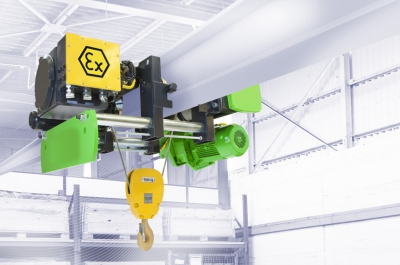These cranes are used in the petrochemical, gas and petrochemical industries, and in areas where flammable gases are present. To avoid this problem, equipment and equipments should be used that will make the possibility of zero and a safe environment for the industry. These cranes can be manufactured in different types and capacities just like conventional cranes.
There are three important parts to making this type of crane:
1. Careful selection of crane working class according to the zone
2. Using appropriate equipment in explosive class
3. Precision in the manufacture and assembly of electrical components
According to International Standard IEC60079-1, workplaces are divided into three zones according to the type and intensity of available gases:
- ZONE 0 : An environment in which a mixture of gas or explosive atmosphere is present permanently or for a long time. This is estimated at more than 1,000 hours a year.
- ZONE 1 : An environment where, under normal conditions, a mixture of explosive gas and atmosphere may occur. This is estimated to be around 10-1000 hours per year.
- ZONE 2 : An environment where, under normal conditions, there is no mixture of gas or explosive air or if it is likely to occur for a short period. This is between 1-10 hours per year.
Classification of Hazardous Areas Containing Dust and Refractory Fiber:
In the case of dusts and in accordance with IEC 61241-3 again, like gases, there are three risk zones defined as ZONE 20, ZONE 21, ZONE 22 which are in fact the zones 0, 1 and 2 respectively of the gases.
- Zone 20: An area in which normal operating conditions, explosive dust, cloud mass, or mass are present, and their amount and concentration are explosive and combustible when combined with air. These dusts may be cloudy clumps of uncontrollable, thick layers of material accumulated on equipment that still have the same explosive properties. These layers or cloud-like masses can form inside confined space operations and pose a danger to the environment. This area, such as zone 0, is flammable in gas or steam environments.
- Zone 21: An area where normal operating conditions may produce a cloud-like mass of explosive dust sufficient to combine with air and create an explosive air dust composition . This area, such as zone 1, is flammable in hazardous environments with gas or vapors.
- Zone 22: An area where, under normal operating conditions, explosive dust clouds may rarely occur and continue for a short time, or in abnormal conditions, cumulative layers of explosive dust may arise. Combined with air, it becomes susceptible to blasting dust. This zone can be created around devices that disperse the operation material in a large space as a result of remote operation, such as zone 2 in explosive gas environments.
Asle Foolad Engineers Co. relying on its strength and experience and using reputable European brands, has implemented numerous oil, gas and petrochemical projects and is a leader in the production of these types of cranes.




